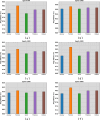Hybridization of synergistic swarm and differential evolution with graph convolutional network for distributed denial of service detection and mitigation in IoT environment
- PMID: 39730632
- PMCID: PMC11680685
- DOI: 10.1038/s41598-024-81116-4
Hybridization of synergistic swarm and differential evolution with graph convolutional network for distributed denial of service detection and mitigation in IoT environment
Erratum in
-
Author Correction: Hybridization of synergistic swarm and differential evolution with graph convolutional network for distributed denial of service detection and mitigation in IoT environment.Sci Rep. 2025 Mar 11;15(1):8439. doi: 10.1038/s41598-025-92451-5. Sci Rep. 2025. PMID: 40069311 Free PMC article. No abstract available.
Abstract
Enhanced technologies of the future are gradually improving the digital landscape. Internet of Things (IoT) technology is an advanced technique that is quickly increasing owing to the development of a network of organized online devices. In today's digital era, the IoT is considered one of the most robust technologies. However, attackers can effortlessly hack the IoT devices employed to generate botnets, and it is applied to present distributed denial of service (DDoS) attacks beside networks. The DDoS attack is the foremost attack on the system that causes the complete network to go down. Thus, average consumers may need help to get the services they need from the server. The compromised or attackers IoT devices want to be perceived well in the system. So, presently, Deep Learning (DL) plays a prominent part in forecasting end-users' behaviour by extracting features and identifying the adversary in the network. This paper proposes a Synergistic Swarm Optimization and Differential Evolution with Graph Convolutional Network Cyberattack Detection and Mitigation (SSODE-GCNDM) technique in the IoT environment. The main intention of the SSODE-GCNDM method is to recognize the presence of DDoS attack behaviour in IoT platforms. Primarily, the SSODE-GCNDM technique utilizes Z-score normalization to scale the input data into a uniform format. The presented SSODE-GCNDM approach utilizes synergistic swarm optimization with a differential evolution (SSO-DE) approach for the feature selection. Moreover, the graph convolutional network (GCN) method recognizes and mitigates attacks. Finally, the presented SSODE-GCNDM technique implements the northern goshawk optimization (NGO) method to fine-tune the hyperparameters involved in the GCN method. An extensive range of experimentation analyses occur, and the outcomes are observed using numerous features. The experimental validation of the SSODE-GCNDM technique portrayed a superior accuracy value of 99.62% compared to existing approaches.
Keywords: Deep learning; Distributed denial of service; Graph Convolutional Network; Internet of things; Northern Goshawk optimization; Synergistic Swarm optimization.
© 2024. The Author(s).
Conflict of interest statement
Declarations. Competing interests: The authors declare no competing interests. Conflict of interest: The authors declare that they have no conflict of interest. The manuscript was written with the contributions of all authors, and all authors have approved the final version. Ethics approval: This article contains no studies with human participants performed by any authors. Consent to participate: Not applicable. Informed consent: Not applicable.
Figures













Similar articles
-
Blockchain enhanced distributed denial of service detection in IoT using deep learning and evolutionary computation.Sci Rep. 2025 Jul 2;15(1):22537. doi: 10.1038/s41598-025-06568-8. Sci Rep. 2025. PMID: 40593035 Free PMC article.
-
A two-tier optimization strategy for feature selection in robust adversarial attack mitigation on internet of things network security.Sci Rep. 2025 Jan 17;15(1):2235. doi: 10.1038/s41598-025-85878-3. Sci Rep. 2025. PMID: 39824955 Free PMC article.
-
Adaptive Machine Learning Based Distributed Denial-of-Services Attacks Detection and Mitigation System for SDN-Enabled IoT.Sensors (Basel). 2022 Mar 31;22(7):2697. doi: 10.3390/s22072697. Sensors (Basel). 2022. PMID: 35408312 Free PMC article.
-
Blockchain Based Solutions to Mitigate Distributed Denial of Service (DDoS) Attacks in the Internet of Things (IoT): A Survey.Sensors (Basel). 2022 Jan 31;22(3):1094. doi: 10.3390/s22031094. Sensors (Basel). 2022. PMID: 35161838 Free PMC article. Review.
-
Systematic Literature Review of IoT Botnet DDOS Attacks and Evaluation of Detection Techniques.Sensors (Basel). 2024 Jun 1;24(11):3571. doi: 10.3390/s24113571. Sensors (Basel). 2024. PMID: 38894365 Free PMC article. Review.
References
-
- Ramprasath, J., Krishnaraj, N. & Seethalakshmi, V. Mitigation services on SDN for distributed denial of service and denial of service attacks using machine learning techniques. IETE J. Res.70 (1), 70–81 (2024).
-
- Kumar, G. & Pragya IPv6 addressing with hidden duplicate address detection to mitigate denial of service attacks in the internet of drone. Concurrency and Computation: Practice and Experience, p.e8131. (2024).
-
- Hnamte, V., Najar, A. A., Nhung-Nguyen, H., Hussain, J. & Sugali, M. N. DDoS attack detection and mitigation using deep neural network in SDN environment. Computers & Security, 138, p.103661. (2024).
LinkOut - more resources
Full Text Sources
Medical

